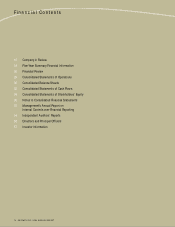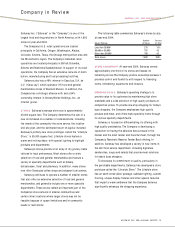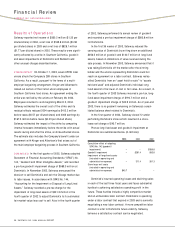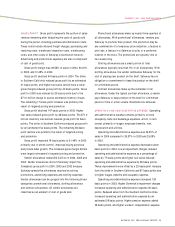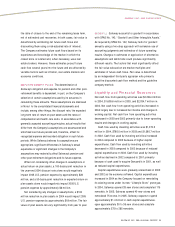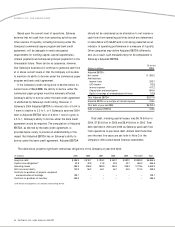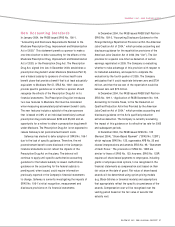Safeway 2004 Annual Report Download - page 25
Download and view the complete annual report
Please find page 25 of the 2004 Safeway annual report below. You can navigate through the pages in the report by either clicking on the pages listed below, or by using the keyword search tool below to find specific information within the annual report.
GROSS PROFIT Gross profit represents the portion of sales
revenue remaining after deducting the costs of goods sold
during the period, including purchase and distribution costs.
These costs include inbound freight charges, purchasing and
receiving costs, warehouse inspection costs, warehousing
costs, and other costs of Safeway’s distribution network.
Advertising and promotional expenses are also a component
of cost of goods sold.
Gross profit margin was 29.58% of sales in 2004, 30.02%
in 2003, and 31.49% in 2002.
Gross profit declined 44 basis points in 2004. The strike
in Southern California reduced gross profit by an estimated
41 basis points, and higher fuel sales (which have a lower
gross margin) reduced gross profit by 40 basis points. Gross
profit in 2003 was reduced by 20 basis points due to the
$71.0 million charge to accrue estimated inventory losses.
The remaining 17-basis-point increase was primarily the
result of targeted pricing and promotion.
Gross profit declined 147 basis points in 2003. Higher
fuel sales reduced gross profit by 38 basis points. The $71.0
million inventory loss accrual reduced gross profit 20 basis
points. The strike in Southern California reduced gross profit
by an estimated five basis points. The remaining 84-basis-
point decline was primarily the result of targeted pricing
and promotion.
Gross profit improved 19 basis points to 31.49% in 2002
primarily due to shrink control, improved buying practices
and private-label growth. The increased gross margin dollars
were largely reinvested in targeted pricing and promotion.
Vendor allowances totaled $2.2 billion in 2004, 2003 and
2002. Vendor allowances did not materially impact the
Company’s gross profit in 2004, 2003 and 2002 because
Safeway spends the allowances received on pricing
promotions, advertising expenses and slotting expenses.
Vendor allowances can be grouped into the following broad
categories: promotional allowances, slotting allowances
and contract allowances. All vendor allowances are
classified as an element of cost of goods sold.
Promotional allowances make up nearly three-quarters of
all allowances. With promotional allowances, vendors pay
Safeway to promote their product. The promotion may be
any combination of a temporary price reduction, a feature in
print ads, a feature in a Safeway circular, or a preferred
location in the store. The promotions are typically one to
two weeks long.
Slotting allowances are a small portion of total
allowances (typically less than 5% of all allowances). With
slotting allowances, the vendor reimburses Safeway for the
cost of placing new product on the shelf. Safeway has no
obligation or commitment to keep the product on the shelf
for a minimum period.
Contract allowances make up the remainder of all
allowances. Under the typical contract allowance, a vendor
pays Safeway to keep product on the shelf for a minimum
period of time or when volume thresholds are achieved.
OPERATING AND ADMINISTRATIVE EXPENSE Operating
and administrative expense consists primarily of store
occupancy costs and backstage expenses, which, in turn,
consist primarily of wages, employee benefits, rent,
depreciation and utilities.
Operating and administrative expense was 26.30% of
sales in 2004 compared to 26.37% in 2003 and 25.09%
in 2002.
Operating and administrative expense decreased seven
basis points in 2004. Lower impairment charges reduced
operating and administrative expense as a percentage of
sales by 77 basis points and higher fuel sales reduced
operating and administrative expense by 39 basis points.
These improvements were offset by a 22-basis-point increase
from the strike in Southern California and 87 basis points due
to higher wages, benefits and occupancy expense.
Operating and administrative expense increased 128
basis points in 2003. Higher Dominick’s impairment charges
increased operating and administration expense 30 basis
points. Reduced sales from the Southern California strike
increased operating and administrative expense by an
estimated 29 basis points. Higher pension expense added
28 basis points, and higher workers’ compensation expense
SAFEWAY INC. 2004 ANNUAL REPORT 23
SAFEWAY INC. AND SUBSIDIARIES



